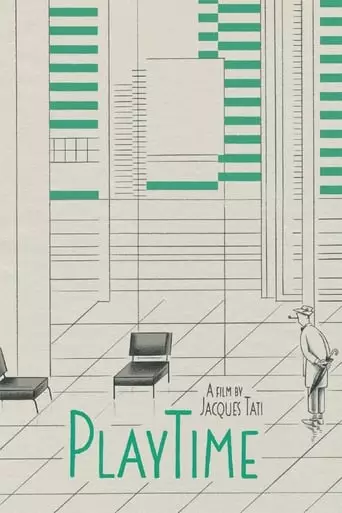
Playtime (1967) Watch Online Free
Clumsy Monsieur Hulot finds himself perplexed by the intimidating complexity of a gadget-filled Paris. He attempts to meet with a business contact but soon becomes lost. His roundabout journey parallels that of an American tourist, and as they weave through the inventive urban environment, they intermittently meet, developing an interest in one another. They eventually get together at a chaotic restaurant, along with several other quirky characters.
Jacques Tati’s Playtime is a unique cinematic masterpiece that is both an exploration of modernist architecture and a biting commentary on the complexities and absurdities of modern urban life. Released in 1967, the film portrays a world dominated by glass, steel, and plastic, where technology, design, and human interaction often clash in comedic ways. Through the character of Monsieur Hulot, Tati crafts a rich visual narrative that presents a society where the triumph of architectural and technological advancement comes at the cost of human warmth and connection. Here’s an analysis, a brief plot summary, and reasons why this film is worth watching.
The film centers on Monsieur Hulot, Tati’s iconic bumbling character, who finds himself navigating a hyper-modern Paris, dominated by futuristic buildings, technological gadgets, and a new kind of urban alienation. The narrative is loose, with minimal dialogue and no clear linear progression. Hulot’s day unfolds as he interacts with a world of impersonal spaces, malfunctioning gadgets, and fragmented human connections. One of the central plotlines involves a group of American tourists struggling to navigate this stark, modern world, providing a contrast to the French citizens who seem to have adapted to the soulless environment.
Much of the film takes place in the enormous set built for Playtime, known as “Tativille,” which was constructed specifically for the film. This sprawling city within a city allows Tati to explore visual gags and scenes that emphasize the disconnect between individuals and their surroundings. The tourists, led by Barbara, wander through this alienating world, trying to make sense of their surroundings, while Hulot’s escapades provide moments of levity amidst the chaos. The film culminates in a chaotic, carnival-like sequence, underlining the absurdity of the modern world.
. The film’s construction of “Tativille” is an actual city built for the movie, allowing for a thorough exploration of the modernist aesthetic.
Watching Playtime leaves you with a sense of bewilderment and amusement. The film is a sensory experience that challenges conventional storytelling, leaving you to reflect on the absurdities of modern life. Initially, you may feel disoriented by the lack of a traditional plot, but as you tune into the intricate visual gags and the subtle critique of society, you’ll find yourself appreciating the film’s deeper messages. By the end, you might also feel a sense of melancholy about the disconnect between humanity and the structures we create, yet you’ll also be captivated by Tati’s genius in making us laugh while reflecting on these profound themes.
In conclusion, Playtime is a film that invites multiple viewings, each one revealing more of its complex humor and profound commentary on modern life. It is a timeless classic that remains relevant as it explores the intersection of architecture, technology, and human behavior.
